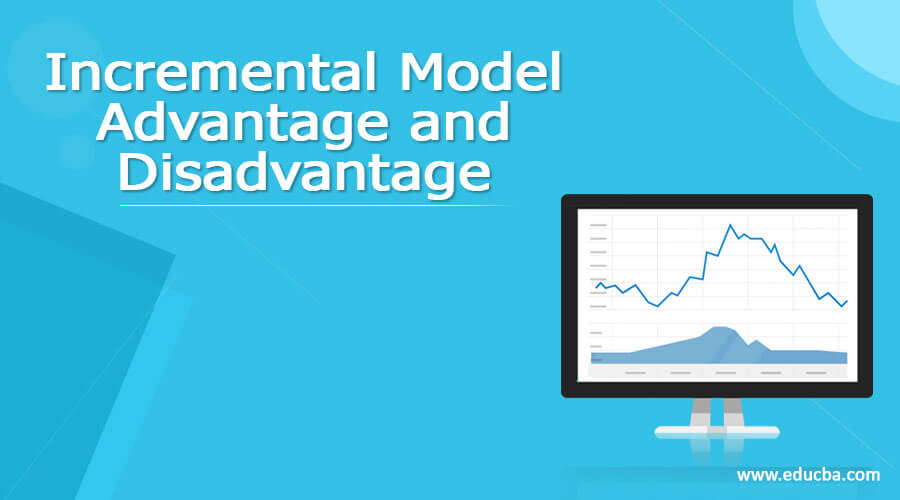Updated July 5, 2023

Incremental Model Advantage and Disadvantage
Incremental model is a process in the software development cycle where we divide the requirement into multiple modules. This module goes through the phases of the model and release is added up until the purpose and the completion of the development model is achieved.
This is a very important model where we divide the requirements into multiple builds and each build is having its own life cycle. All the required phases of development are done over all the modules so that the module has its tasks and works well tested. The Requirement, Design, Implementation, and Testing phase is done by all the modules and each module release adds up a new function to the previous release.
This basically shows up that incremental work is done and the development of the software is smooth and lighter. It can be also mentioned as step by step development of a Product. This incremental model is widely used in various data industries and is one of the best practices for data development activities.
In this article, we will try to analyze the advantages and disadvantages of the Incremental Model. Let us try to see about an incremental model in more detail.
Model Advantage and Disadvantage
As this model is a step-by-step module-based development model, this model has certain advantages and disadvantages also that we can see incur. Let us check about some of the Advantages and Disadvantages of the same.
Advantages
1. Distribution of modules makes the SDLC easier.
2. This model is Cost Efficient.
3. Resources are properly utilized as per skill set.
4. Smooth and Good Learning Graph.
5. Comparatively leads to faster product delivery.
6. Risk can be managed easily.
7. Different release models can be put.
8. Functionalities are achieved, analyzed, and checked thoroughly throughout.
9. Exposure to new technologies.
10. Previous Model architecture can be reused further and save time.
11. Errors can be easily recognized throughout.
12. Easier to debug.
13. Functionality wise release
14. Better Support throughout the SDLC.
15. Fair Idea about the functioning of each module and integration techniques.
16. Version Modification is easy.
17. The core functionalities development can be achieved as per client and product usage.
Disadvantages
1. Need very good planning over the model.
2. The module breakage should be properly planned.
3. The whole system needs out to be known well prior to going for the modules.
4. The Total cost sometimes is high.
5. Different modules can need a different interface that can be a new setup sometimes.
6. Pipelining or release can be delayed sometimes in case of any cross-module dependency.
7. The end-to-end design diagram should be very clear to the developer.
8. Early definition of the module needs to do.
There are different types of Incremental Model some being:-
- Staged Delivery:
Only a single part of the project is done at a time. This involves the commitment of the team over a single module that can be pushed after the successful release of the same. This model is needed when there is cross demo approval required where stage-by-stage monitoring of the product can take place though.
- Parallel Development:
This model involves the approach where multiple modules can be worked on at the same time and the functionality can be achieved. This model is faster and is totally dependent on the workforce a product is having. The scheduled deliveries can be achieved by this model. Divide and conquer mechanism can be done to achieve this. Incremental Resource deployment can be done using this model of development.
When to use this Model?
This model can be used when the business has the following requirements:
1. The domain of the product is new.
2. The Team and tech stack is new.
3. Step by Step logging and demo are needed.
4. The requirements are prioritized.
5. The basic functionality needs to deliver fast.
6. If the Product needs to go to market early.
7. Some of the module details are gathered or may come up with time.
8. The End to end system is understood properly.
9. Business is over the low-risk phase.
10. No overlapping of modules takes place.
11. Easier to manage risk and downtime can prevail in case of any enhancement over the model.
12. Infra is clear with no blockers.
13. Approvals are not time taking and longer.
Conclusion
From the above article, we saw about the incremental model. From this article, we tried to understand the advantages and disadvantages of this model and what is used in SDLC. The various advantages showed why this model is widely accepted throughout.
We also saw the advantages of the Incremental model and its usage for various programming purposes.
Recommended Articles
This is a guide to Incremental model Advantage and Disadvantage. Here we discuss Incremental model Advantage and Disadvantage. You may also have a look at the following articles to learn more –
